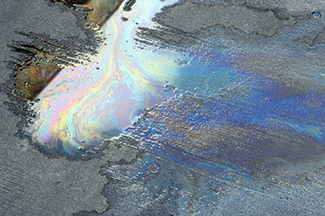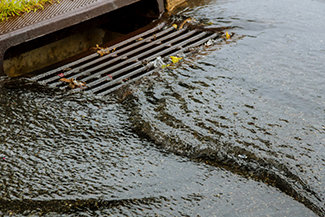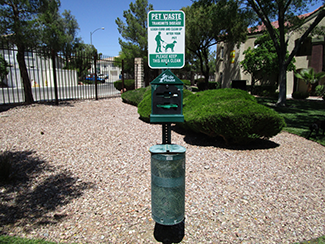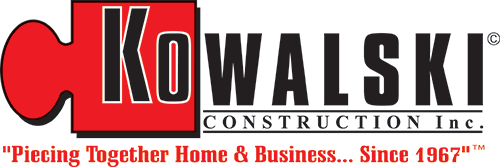Why Managing Stormwater on Your Property Is Important
Why Managing Stormwater on Your Property Is Important
Stormwater, also called runoff or surface water, is a part of the natural hydrologic process.
Stormwater is generated from rain and snowmelt that flows over land or impervious surfaces such as paved streets, parking lots, and building rooftops and does not soak into the ground. The water that does not infiltrate into the ground, evaporate, or used by plants will flow into lakes, creeks, streams, coastal waters, and ditches.
As it flows, the runoff picks up trash, chemicals, oils, dirt, and sediment that can pollute the water.
Common pollutants in stormwater include pesticides, fertilizers, litter, pet waste, petroleum products, automotive fluids, paints, solvents, yard waste, sediment, chemicals, and other materials.
Controlling Stormwater Pollutants
 The Environmental Protection Agency (EPA) has estimated that about 30 percent of known pollution to our nation's waters is attributable to stormwater runoff. To mitigate that, in 1987, Congress directed the EPA to develop a regulatory program to address the stormwater problem and issued regulations in 1990 authorizing the creation of a National Pollutant Discharge Elimination System (NPDES) permitting system.
The Environmental Protection Agency (EPA) has estimated that about 30 percent of known pollution to our nation's waters is attributable to stormwater runoff. To mitigate that, in 1987, Congress directed the EPA to develop a regulatory program to address the stormwater problem and issued regulations in 1990 authorizing the creation of a National Pollutant Discharge Elimination System (NPDES) permitting system.
On December 05, 2002, Arizona became one of 45 states with authorization from EPA to operate the NPDES Permit Program (Section 402 of the Clean Water Act) on the state level under the Arizona Pollutant Discharge Elimination System (AZPDES) Permit Program.
To protect our water resources, communities, construction companies, industries, and others, use stormwater controls, known as best management practices (BMPs). These BMPs filter pollutants and/or prevent pollution by controlling it at its source.
As the City of Chandler explains, "When it rains in urban areas, the stormwater runs off buildings and paved areas instead of soaking into the ground. The stormwater collection system, also known as the storm drain system, is designed to move stormwater flows along conveyances like city streets and gutters where it is directed into storm drains or spillways constructed along the street, and eventually deposited into retention basins, greenbelt areas, parks, and lakes within the community.”
As the runoff moves downhill, natural vegetated depressions and other features slow the flow of water and remove some pollutants and sediments. In Prescott Valley, for example, existing vegetation and topography have been altered, graded, or paved. Stormwater is diverted into their lakes through creeks, ditches, scuppers, drainpipes, and other diversionary features.
Most municipality codes do not allow stormwater or drainage to flow from one property to another as the water makes its way to the street. Homeowners and commercial property owners are required to keep their lots maintained so the water flows away from others and to the street or whatever drainage system the property is designated. In a big subdivision, you will see large basin areas that look like parks. They are really for water retention. Runoff from the houses in that neighborhood is removed through streets, washes and ditches to the main drainage area.
The Homeowner’s Responsibility
 “Stormwater should flow to a street or drainage system and not another property,” says Jim Kowalski, Partner, Kowalski Construction, Inc ., a Rosie-Certified Partner. “Stormwater management is the homeowner’s responsibility, not the city.”
“Stormwater should flow to a street or drainage system and not another property,” says Jim Kowalski, Partner, Kowalski Construction, Inc ., a Rosie-Certified Partner. “Stormwater management is the homeowner’s responsibility, not the city.”
Most municipalities offer guidelines and suggestions for homeowners. For example, The City of Chandler’s Stormwater Program educates the community on environmental regulations. Chandler works with state and federal regulators to make sure residents understand the effects of stormwater drainage and how to reduce pollutants into the storm drain system. They offer free presentations about stormwater pollution prevention for schools, community groups, homeowners, and neighborhood associations. Check with your municipality to find out if they offer such programs.
The EPA and Kowalski Construction offers these tips to prevent stormwater pollution:
- Keep yard clippings out of the street.
- Dispose of household chemicals properly by following the directions on the package or by calling the local public works department for proper disposal guidelines.
- Clean up oil spills and fix leaking automobiles.
- Use drip pans to catch engine oil and other pollutants while repairing cars.
- Recycle used motor oil.
- Sweep driveways clean instead of hosing them down.
- Water your lawn by hand or adjust sprinklers to avoid over-watering. If any water flows off your lawn, you're using too much water. (Also, consider replacing the lawn with xeriscape.)
- Wash your car at a commercial car wash, or at least wash your car on an unpaved surface so the excess water can be absorbed by the ground.
- Drain swimming pools and spas into a sanitary sewer outlet, never into a street.
- Check first with your local wastewater treatment plant before disposing of anything in the sewer.
- Locate the nearest storm drains and protect them from debris and other materials before beginning an outdoor project.
 Report illegal dumping or littered areas.
Report illegal dumping or littered areas.- Don't dump waste into storm drains.
- Avoid chemical discharge into drains.
- Store chemicals properly.
- Prevent substance leaks & spills.
- Use an absorbent material for cleanup.
- Donate or dispose of paint properly.
- Consider washing vehicles on lawns instead of driveways.
- Maintain sprinkler/irrigation systems.
- Maintain pool auto fills.
- Use a screen on a sump pump or trash pump when draining stormwater.
- Keep yards clean of leaves and pet waste.
Plus, the City of Litchfield Park Public Works Department provides A Homeowner’s Guide To Healthy Stormwater Habits with tips.
If the rainfall is so heavy that your property floods, you may need to use a sump pump to redirect the water so it does not flow to another property. Sump pumping uses a motor and a pump connected to a hose running to the basin where the pump is placed. The pump sends water through the hose and out to your designated drain area. Call the county to find out where your designated drainage area is located. Don't assume it's the street.
A note about remodeling : If you are remodeling the exterior of your home or making changes to your landscape, be sure the contractor considers storm and standing water drainage in the plan and applies for the required permits.
“The Arizona Department of Environmental Quality (ADEQ) requires a Construction General Permit (CGP) and a Stormwater Pollution Prevention Plan (SWPPP) for construction projects that discharge stormwater into waterways,” notes Kowalski.
The Benefits of Stormwater
A rainstorm quenches the dry land's thirst and provides other benefits as noted by the EPA.
Beautify neighborhoods – When we soak up the rain with trees and rain gardens in our yards and in our cities, we're adding beauty to the landscape.
Cool the air - When we soak up the rain by planting trees and other plants in our urban neighborhoods we're helping to cool the air and reduce urban heat islands.
Save money - When we soak up the rain and reduce the runoff that flows to the street, we reduce the water to be handled by the town drainage systems. This can help lower community costs for managing this water. Green roofs can lower building energy costs; permeable pavements can lower construction costs for residential and commercial development by reducing the need for some conventional drainage features.
Create habitat - When we plant trees, grasses, and flowering perennials, especially native plants suitable for the area, we create habitat for birds and insects such as butterflies, bees, and other pollinators.
When we take action to soak up the rain, we keep rain closer to where it falls and reduce the runoff from our roofs, driveways, and parking lots. Reducing runoff can help prevent water pollution, reduce flooding, and protect our precious drinking water resources. When we soak up the rain, we also help beautify our neighborhoods and bring many other benefits to our communities.
Home Maintenance To-Do | #StormWater
###
Podcast
When it rains in Arizona, it can be very heavy and cause flooding around your property. Jim Kowalski of Kowalski Construction, who specializes in water damage restoration, talks about ways to avoid that stormwater damaging your property and the environment. Also, Sweet Jennifer discusses the many things she found at the KBIS Show to assist the elderly and their challenges. And more!
Sponsored by Kowalski Construction
 We have been proudly serving Arizona since 1967.
We have been proudly serving Arizona since 1967.
As a nationally recognized, award-winning construction, remediation and restoration company, our family operated, and locally Phoenix-owned business will treat you like family. Kowalski Construction’s Emergency 24/7 Service and non-emergency service covers everything from fire and water damage, mold remediation, structure board-up, asbestos & hazardous material removal, structure drying, construction services, structure and water restoration and electrical work.
Photo Credit
- Shutterstock
Related Content
- EPA Video: EPA Stormwater Video
- Blog: Water Usage & Conservation
- DIY FAQ: Simple Water Conservation Tips For Home, Work, And School
- DIY FAQ: Water-Saving Ways To Grow Your Desert Garden
- DIY FAQ: Will Arizona Have To Turn Off The Tap, Too?
- DIY FAQ: Tips To Decrease Your Household Water Consumption
